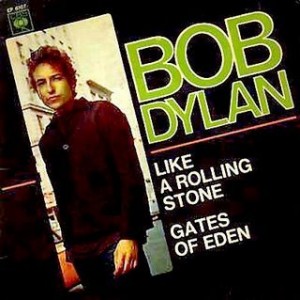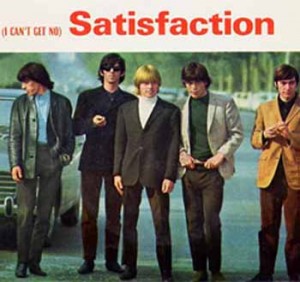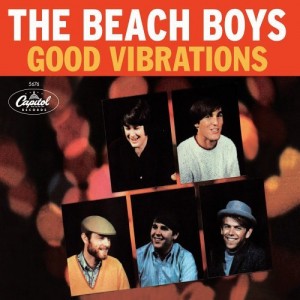 Up until the late 1960’s it was rare that a Top 40 hit single broke the three-minute mark. Sure, there were exceptions, such as Bob Dylan’s “Like a Rolling Stone” and The Rolling Stones’ “(I Can’t Get No) Satisfaction,” both of which ran well over three minutes. But so much was exceeding the three-minute barrier considered a commercial kiss of death that producer Curt Boettcher instructed Valiant Records to print 3:00 on the label of The Association’s recording of “Cherish” for fear that printing the actual time (3:30) would be an impediment to radio play. Whether or not the intentional mis-labeling had any effect on broadcast decisions, the record was a gigantic hit.
Up until the late 1960’s it was rare that a Top 40 hit single broke the three-minute mark. Sure, there were exceptions, such as Bob Dylan’s “Like a Rolling Stone” and The Rolling Stones’ “(I Can’t Get No) Satisfaction,” both of which ran well over three minutes. But so much was exceeding the three-minute barrier considered a commercial kiss of death that producer Curt Boettcher instructed Valiant Records to print 3:00 on the label of The Association’s recording of “Cherish” for fear that printing the actual time (3:30) would be an impediment to radio play. Whether or not the intentional mis-labeling had any effect on broadcast decisions, the record was a gigantic hit.
But in the mid-to-late 1960’s, largely due to the burgeoning length of Bob Dylan’s songs and to acknowledge a new legion of guitar heroes, it became a mantra among the then-emerging breed of rock critics that the time parameters of Top 40 radio placed unreasonable constraints on the flowering artistic expressions of rock artists.
 The critics’ complaint, of course, fully ignored the fact that the vast majority of Beatles recordings were well under three minutes. In fact, most of their material up to and including the songs on “Sgt. Pepper” averaged less than 2:30 – and nobody ever accused The Beatles of scrimping on either their artistic expressions or their commercial viability.
The critics’ complaint, of course, fully ignored the fact that the vast majority of Beatles recordings were well under three minutes. In fact, most of their material up to and including the songs on “Sgt. Pepper” averaged less than 2:30 – and nobody ever accused The Beatles of scrimping on either their artistic expressions or their commercial viability.
For my money, I am convinced that AM radio’s self-imposed time constraints often forced producers and bands to focus their attention and express themselves more concisely. For example, “Good Vibrations” was over 16 minutes long before Brian Wilson, who was then at the height of his creative powers, trimmed it to the length we all know now, while still realizing his artistic intentions of creating a “pocket symphony” full of identifiable self-contained movements and thematic progression.
But consider other examples: I mean, it takes only one listen to the full 17-minute version of “In-A-Gadda-Da-Vida” to praise the wisdom of Atlantic Records in insisting that 14 minutes be shaved from the song so that it would clock in at 2:53 and be guaranteed radio play. (And, frankly, I know nobody who pines for the missing 14 minutes!) As well, virtually no one argues that the longer, meandering album version of The Doors’ “Light My Fire” is superior to the radio-length version.
 Now, it is true that some singles that hit the top of the charts were actually artistically harmed by the machinations of shortening them for radio – the poorly executed primary edit in Chicago’s “Make Me Smile” (which was part of a longer suite of songs) comes to mind, as does the decision to replace Blood Sweat & Tears’ jazz instrumental section of “Spinning Wheel” with a bad 4-bar guitar solo.
Now, it is true that some singles that hit the top of the charts were actually artistically harmed by the machinations of shortening them for radio – the poorly executed primary edit in Chicago’s “Make Me Smile” (which was part of a longer suite of songs) comes to mind, as does the decision to replace Blood Sweat & Tears’ jazz instrumental section of “Spinning Wheel” with a bad 4-bar guitar solo.
But if you press most record collectors who bought one of those late ’60s albums that featured a side-long jam session, I suspect the majority will admit preferring the record’s other side – the side with 3-minute songs. With rare exceptions, most of the prolonged jams featured nothing more than masturbatory noodling and were neither particularly artistic nor revelatory.
For the purposes of my argument – i.e., that AM radio’s time constraints actually improved the quality of rock records – I want to concentrate on 1968, the year psychedelia was at its peak and long improvisational solos dominated rock records. After all, it’s a moot point to make the argument for records of the early-to-mid ‘60s, when “The Loco-Motion,” “Pretty Woman,” and “Wild Thing,” ruled the charts. Their genius lay in their pithy brevity, and no one – certainly, not the songwriters nor the producers, and not the performers or the record company – were clamoring to make them longer. But as rock artists became more ambitious in their goals, it required a great deal of focus to create singles that would both contain their artistic ideas and be commercially viable – all while staying within the confines of radio’s time restraints.
But it could be done. And it didn’t always require editing to meet those demands. After all, most late ‘60s bands had grown up with Top 40 radio as their standard to begin with, and they wrote and recorded with an understanding that the end-product would be a 3-minute-or less 45 RPM record. Take, for example, one of the most famous acid-rock singles of the era – “Purple Haze.” It runs only 2:42. Certainly, a guitarist of Jimi Hendrix’s inventiveness and ability could’ve improvised on the song for hours. But the point is: he didn’t. And the record loses none of its power because he didn’t.
But that’s too easy an example, and I’d rather concentrate on some of the forgotten hits of 1968 – records that remained true to the precepts of psychedelia while clocking under 3:00.
First up is “Hot Smoke & Sassafrass,” a delicious slice of psychedelia that reached #14 on the charts in 1968. Recorded by the barely remembered Texas acid rock band, Bubble Puppy, it contains so many cool ideas within 2:43 that it almost could be considered an early blast of prog rock. When my brother recently heard the song for the first time in decades, he commented, “With all the changes in this, it actually seems much longer!”
.
.
Or take “Omaha” by the ill-fated Moby Grape, one of San Francisco’s premiere bands at a time when it seemed that every band in the city was being signed to record deals. The Grape featured three excellent guitarists, and despite the competition from Jefferson Airplane, Janis Joplin with Big Brother & The Holding Co., and Quicksilver Messenger Service, Moby Grape was widely thought to be the leading contender for the title of “The Beatles of Acid Rock.” Columbia Records was so convinced that the Grape was the Next Big Thing that their promotional campaign to introduce the band to the rest of the country was to simultaneously release five singles from their dazzling debut LP! Unfortunately, deejays didn’t know which of the five singles to play, and all five got lost in the shuffle. Nonetheless, although “Omaha” may have charted only as high as #88, it lives on as two-minutes-and-thirty-seconds of acid rock heaven, complete with reverbing backwards sound effects, catchy melodic hooks, and dueling guitars. And nothing’s left out, despite its sub-three-minute length.
.
.
And speaking of leaving nothing out, the producer of the next track must’ve had a helluva good time in the studio, throwing everything but the kitchen sink into the production mix (is that a balloon being scratched?). Balloon Farm’s “Question of Temperature” was bubblegum acid-rock, but what a fun kick it was, and I can’t hear this nearly forgotten Top 40 gem without failing to think of it blasting from the car radio while Connie Atkinson and I cruised all over town in my ’56 Chevy back in ‘68.
.
.
So tell me: did any of these records suffer from having their creative expressions squelched by Top 40 radio’s time constraints? or are they pretty much perfect as they are – fully formed and fully expressive? And in this day and age when virtually all popular recordings are well over 3:00 and often much longer, is the longer length required? and does it guarantee a level of accomplishment that would be otherwise lost? (I would offer as Exhibit A: REM, whom I think was a better band on their first handful of albums that were chockfull of 2-3 minute songs, compared to the much more serious band that recorded self-indulgent 4-minute tomes on “Automatic for the People” and subsequent albums.)
– Rich Horton, the Pallid Pilgrim
(For more articles by Rich Horton, click here.)
.


